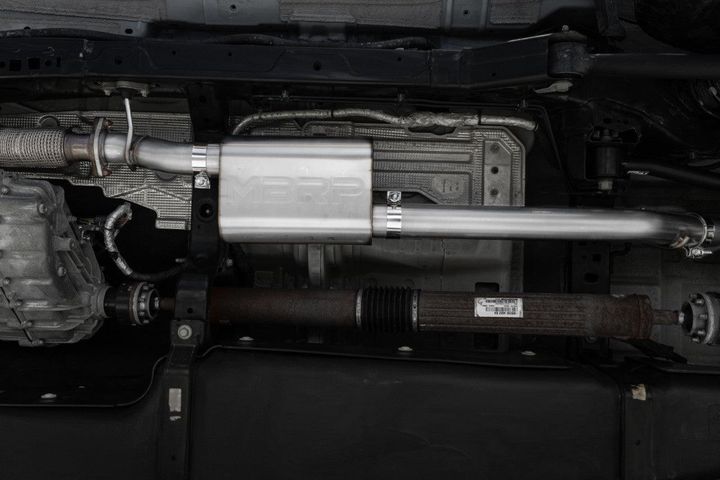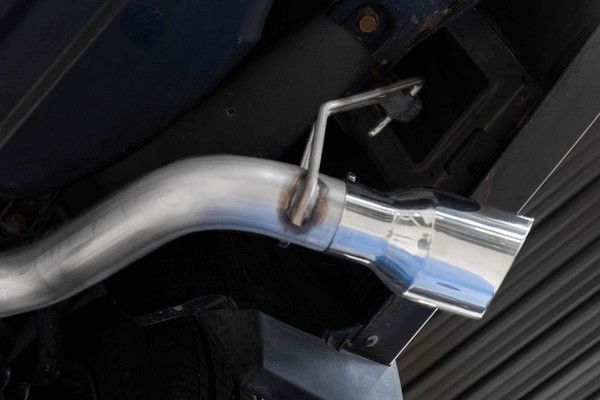


Automotive exhaust systems play a crucial role in managing emissions and ensuring optimal vehicle performance. Among the various materials used in their construction, aluminized steel has emerged as a popular choice, offering a compelling balance of corrosion resistance, durability, and cost-effectiveness. In this comprehensive article, we'll delve into the intricacies of aluminized steel car exhaust systems, exploring their composition, performance characteristics, applications, installation considerations, and maintenance requirements. By understanding the nuances of this material, you'll be better equipped to make an informed decision for your vehicle's exhaust system needs.

Aluminized steel exhaust systems are constructed from mild steel coated with an aluminum-silicon alloy through a hot-dip process. This coating creates a metallurgical bond between the steel and the aluminum-silicon alloy, enhancing the overall corrosion resistance and high-temperature performance of the exhaust system.
The mild steel core provides the necessary structural strength and durability, while the aluminum-silicon coating acts as a sacrificial anode, protecting the underlying steel from corrosion. This combination of materials offers improved corrosion resistance compared to bare mild steel, making aluminized steel a cost-effective alternative to stainless steel exhausts.
| Material | Properties |
|---|---|
| Mild Steel Core | - Provides structural strength and durability - Susceptible to corrosion without coating |
| Aluminum-Silicon Coating | - Acts as a sacrificial anode - Enhances corrosion resistance - Improves high-temperature resistance |
At the heart of an aluminized steel exhaust system lies mild steel, an alloy of iron and a small percentage of carbon. This steel base is coated with an aluminum-silicon alloy through a hot-dip process, where the components are immersed in a molten aluminum-silicon bath. The silicon in the alloy enhances the coating's adherence to the steel surface and improves its resistance to high temperatures.
The hot-dip coating process creates a strong metallurgical bond between the steel and the aluminum-silicon alloy, ensuring the coating's durability and longevity. This manufacturing technique is crucial in providing aluminized steel exhaust systems with their unique properties and performance characteristics.
While aluminized steel offers superior corrosion resistance and a longer lifespan compared to bare mild steel, it is not as corrosion-resistant as stainless steel. Stainless steel contains chromium and other alloying elements that form a passive oxide layer, providing exceptional protection against oxidation and corrosion.
However, aluminized steel exhaust systems offer a more cost-effective alternative to stainless steel, making them an attractive choice for budget-conscious vehicle owners or those seeking a balance between performance and cost.
| Material | Corrosion Resistance | Cost |
|---|---|---|
| Bare Mild Steel | Low | Lowest |
| Aluminized Steel | Moderate | Moderate |
| Stainless Steel | High | Highest |
One of the primary advantages of aluminized steel exhaust systems is their ability to withstand high temperatures and resist corrosion. The aluminum-silicon coating acts as a barrier, protecting the underlying steel from the harsh environment inside the exhaust system, where temperatures can reach up to 800°C (1,472°F) or higher.
While aluminized steel is not as corrosion-resistant as stainless steel, it offers a significant improvement over bare mild steel. In mild climates or areas with minimal exposure to road salt and moisture, a well-maintained aluminized steel exhaust system can last for several years, often outlasting the vehicle's expected lifespan.
However, it's important to note that the aluminized coating can be compromised by severe impacts or abrasions, exposing the underlying steel to potential corrosion. Additionally, in coastal areas or regions with heavy road salt usage during winter, the lifespan of an aluminized steel exhaust system may be reduced due to accelerated corrosion.
Factors Affecting Longevity:
Driving conditions (e.g., exposure to road salt, moisture)
Climate (e.g., coastal areas, harsh winters)
Maintenance practices
Impacts or abrasions to the coating
The aluminum-silicon coating's ability to withstand high temperatures is a key factor in the performance of aluminized steel exhaust systems. The coating acts as a barrier, protecting the underlying steel from the harsh environment inside the exhaust system, where temperatures can reach up to 800°C (1,472°F) or higher.
This high-temperature resistance ensures that aluminized steel exhaust systems can maintain their structural integrity and performance over an extended period, even under demanding driving conditions.
Aluminized steel exhaust systems are commonly used in a variety of vehicle applications, including daily drivers, light trucks, and off-road vehicles. Their balance between performance, durability, and cost-effectiveness makes them a popular choice for many vehicle owners.
In mild to moderate climates, where exposure to road salt and moisture is minimal, aluminized steel exhaust systems can be an excellent choice. They provide improved corrosion resistance compared to bare mild steel, while still offering a more affordable alternative to stainless steel exhausts.
However, in coastal areas or regions with harsh winters and heavy road salt usage, stainless steel exhaust systems may be a better choice due to their superior corrosion resistance. The accelerated corrosion caused by salt exposure can compromise the lifespan of aluminized steel exhaust systems in these environments.
For high-performance vehicles or applications where maximum durability and longevity are paramount, stainless steel exhausts may be the preferred option. While aluminized steel offers improved performance over bare mild steel, stainless steel remains the gold standard for exhaust systems in demanding applications.
| Vehicle Application | Recommended Exhaust Material |
|---|---|
| Daily Drivers (Mild Climates) | Aluminized Steel or Stainless Steel |
| Light Trucks (Moderate Climates) | Aluminized Steel or Stainless Steel |
| Off-Road Vehicles | Aluminized Steel or Stainless Steel |
| Coastal Areas / Harsh Winters | Stainless Steel |
| High-Performance Vehicles | Stainless Steel |

Installing an aluminized steel exhaust system is generally similar to installing a mild steel or stainless steel system. However, there are a few key considerations to keep in mind.
When installing an aluminized steel exhaust system, it's crucial to follow the manufacturer's instructions carefully, as some components or installation techniques may differ from other materials. One key consideration is the use of proper clamps and hangers.
Aluminized steel can be more prone to galvanic corrosion when in direct contact with dissimilar metals, such as stainless steel clamps or hangers. Using compatible clamps and hangers designed specifically for aluminized steel can help prevent this issue and ensure the longevity of the exhaust system.
Installation Tips:
Follow manufacturer's instructions
Use compatible clamps and hangers
Avoid contact with dissimilar metals
To maximize the lifespan of an aluminized steel exhaust system, regular maintenance and inspections are recommended. This includes checking for any signs of damage, corrosion, or leaks, and addressing any issues promptly.
Keeping the exhaust system clean and free from road debris and salt buildup can also help prevent premature corrosion. Following the manufacturer's recommended maintenance schedule and using compatible replacement parts can further extend the life of the exhaust system.
Maintenance Recommendations:
Regular inspections for damage, corrosion, or leaks
Clean the exhaust system to remove debris and salt buildup
Follow manufacturer's maintenance schedule
Use compatible replacement parts
One of the primary advantages of aluminized steel exhaust systems is their cost-effectiveness. While not as inexpensive as bare mild steel exhausts, aluminized steel systems offer a more affordable alternative to stainless steel, particularly for budget-conscious vehicle owners or those looking for a balance between performance and cost.
The overall cost of an aluminized steel exhaust system can vary depending on factors such as the vehicle make and model, the exhaust configuration (e.g., cat-back, header-back, etc.), and any additional components required (e.g., catalytic converters, mufflers, tips).
While the initial investment may be lower than a stainless steel system, it's important to consider the long-term value and potential maintenance costs when evaluating the cost of an aluminized steel exhaust system. More frequent replacements or repairs may be required in certain environments or driving conditions.
Cost Factors:
Vehicle make and model
Exhaust configuration (cat-back, header-back, etc.)
Additional components (catalytic converters, mufflers, tips)
Long-term maintenance costs
Many reputable manufacturers offer warranties or guarantees on their aluminized steel exhaust systems, providing added peace of mind and protection for your investment. These warranties can cover defects in materials and workmanship, ensuring that you receive a high-quality product that meets the manufacturer's standards.
By considering the initial cost, long-term value, and manufacturer warranties, you can make an informed decision that aligns with your driving needs, budget, and desired level of protection for your exhaust system investment.
Aluminized steel exhaust systems offer a compelling combination of performance, durability, and cost-effectiveness for many vehicle owners. By understanding the construction, materials, applications, and maintenance requirements of these exhaust systems, you can make an informed decision that aligns with your driving needs and budget. Whether you're seeking a balance between performance and affordability or prioritizing longevity in mild to moderate climates, aluminized steel exhaust systems present a viable option worth considering.
When evaluating aluminized steel exhaust systems, consider factors such as your vehicle's application, driving conditions, and budget. Weigh the initial cost against the long-term value and potential maintenance requirements. Additionally, take advantage of manufacturer warranties and guarantees to protect your investment.
Ultimately, aluminized steel exhaust systems offer a compelling middle ground between the affordability of mild steel and the durability of stainless steel, making them a popular choice for a wide range of vehicle owners seeking a balance of performance, cost-effectiveness, and longevity.
Galvanized steel is coated with zinc, while aluminized steel is coated with an aluminum-silicon alloy. Aluminized steel offers better heat resistance compared to galvanized steel.
The steel is cleaned, dipped in a molten aluminum-silicon bath, shaken, removed, and air-dried to create a metallurgical bond between the steel and aluminum coating.
Adding silicon helps create a thinner aluminum layer on the steel. It also promotes better adherence of the aluminum coating to the steel.
Aluminized steel can withstand temperatures up to 1,470°F (800°C) with almost no change in the base steel material.
Aluminized steel shows better corrosion resistance than regular steel, but stainless steel has superior corrosion resistance due to its chromium content.
If the aluminum coating is disrupted and the steel core is exposed, the steel may oxidize and corrode over time.
Type 1 is coated with an aluminum-silicon alloy containing 5-11% silicon, while Type 2 is coated with commercially pure aluminum.
Type 1 aluminized steel is commonly used for mufflers, furnaces, ovens, ranges, heaters, water heaters, fireplaces, and baking pans.
Type 2 aluminized steel is commonly used for corrugated roofing, siding, grain bins, drying ovens, and air conditioner condenser housings.
At temperatures up to 1,548°F (842°C), aluminized steel reflects up to 80% of projected heat, which is higher than most other materials.

Sarah isn't your average gearhead. With a double major in Mechanical Engineering and Automotive Technology, she dived straight into the world of car repair. After 15 years of turning wrenches at dealerships and independent shops, Sarah joined MICDOT to share her expertise and passion for making cars run like new. Her in-depth knowledge and knack for explaining complex issues in simple terms make her a valuable asset to our team.








